Abigail Susik
All images from the collection of the Hallie Ford Museum of Art, Willamette University, Salem, Oregon unless noted.
One of the reasons for abstract art’s ascendancy over the last century is surely its simultaneous accommodation of the ego’s conflicting desires for both symbolic annihilation and reflection of the self.
On the one hand, the formal hermeticism and token minimalism of visual abstraction may provide a rest from the ego’s incessant interjections. In the devastating silence of Rothko’s chapel, for instance, the relentless noise of the self is absorbed into the quicksand of pure pigment. This has been called “visual purity” or “optical transcendence,” but another way to think about it is simply as a temporary cessation of narcissism.
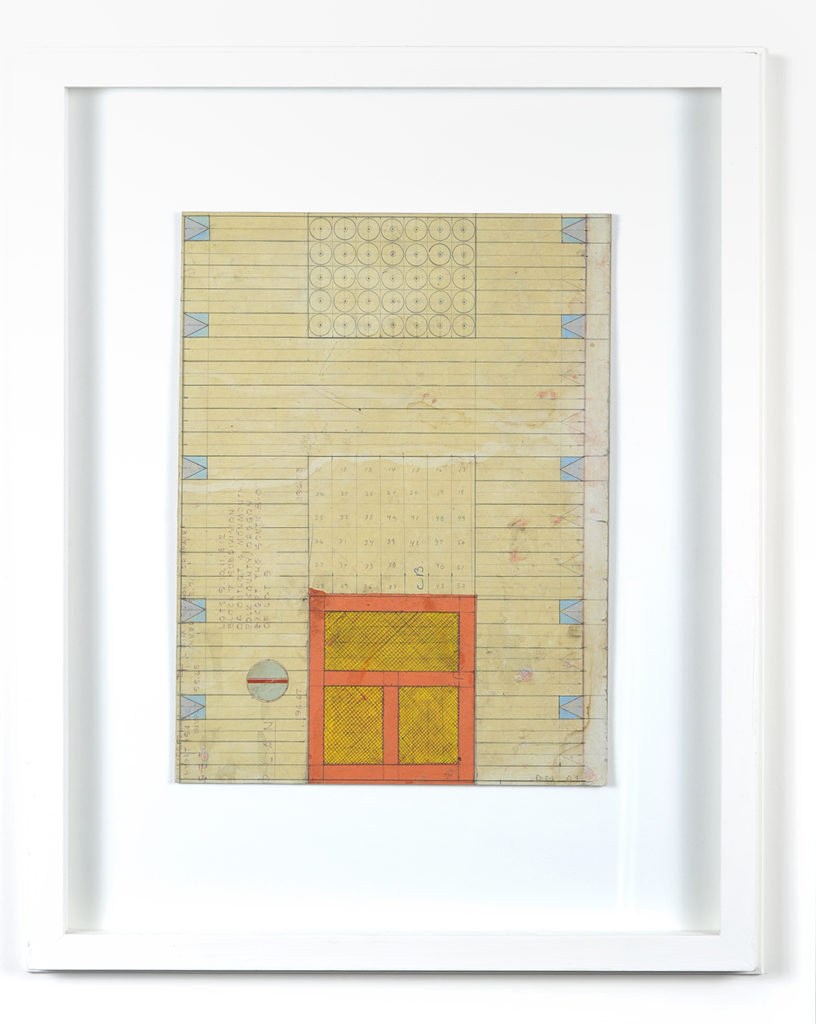
DE May, Reservoir District (224), 2001, Mixed Media. 12 x 9 inches
On the other hand, much abstract art has the potential to figure as a metaphorical plaything for the beholder’s fantasies and identifications. Associatively, Mondrian’s grid becomes a cityscape, a microchip, or a representation of the Platonic ideal. In a biomorphic example, Anish Kapoor’s Cloudgate morphs into the Chicago Bean, generating a selfie maelstrom. The paradoxical pliancy of abstraction’s reserve supports the inevitable intrusion of the ever-formulating universe of the individual viewer.
However, the dual obduracy and porousness of abstraction can neither be taken as the summation of a viewer’s experience, nor as a given precept of an artist’s impetus or approach. There may still be room to uncover unexpected permutations in abstraction’s presumed operations. At some point, it may no longer be the case that most viewers default to modalities of self-engagement when they confront artworks constructed in the languages of abstraction.
What then becomes of contemporary practices that resist engagement with the beholder’s narcissism? Such artworks possess immunity to the desire for denial or access, not because of the work’s avoidance of familiar formal tropes such as linear, curvilinear, or gestural structures, but as a result of the inscrutable specificity of their construction.
What is the nature of an artistic practice of abstraction that is at once entirely concrete and fully opaque?
Can we embrace an abstract art that fails to offer envelopment, quiescence, or the pleasure of free association?
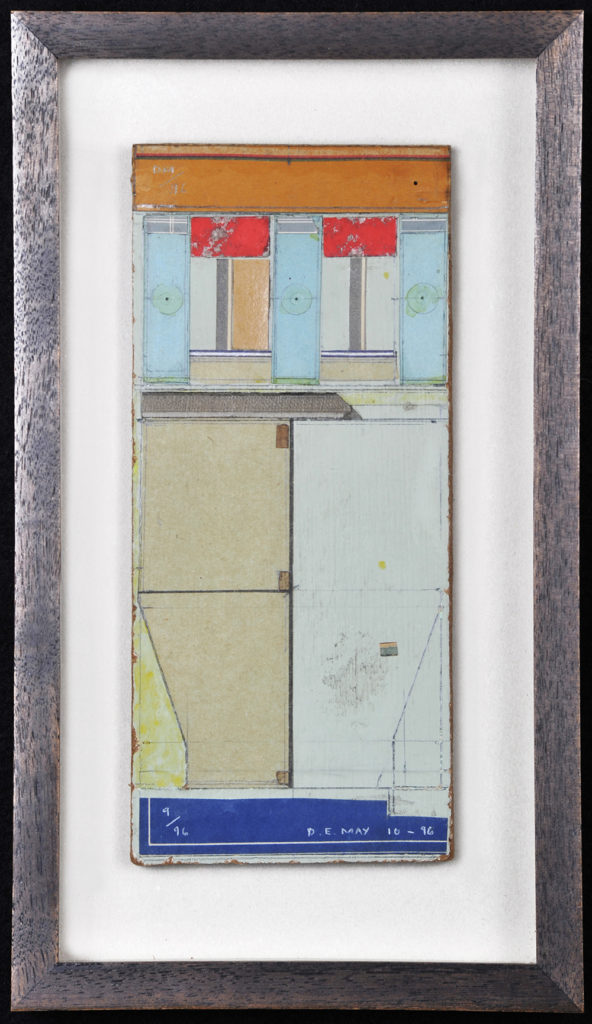
DE May, Reservoir District (224), 2001, Mixed Media. 12 x 9 inches
It was the Oregon artist D. E. May (1952-2019) who taught me this difficult and redemptive lesson over the past decade: his art would never be fully knowable as a result of the depths of its idiosyncratic essence.
Don’t let the languages of modernist abstraction so often present in this artist’s work across media—from drawings, to collages, to assemblages, and mail art—fool you. There is no empathetic experience there to comfort or console, no moment of peaceful respite from yourself, nor even an anonymous surface onto which you can project.
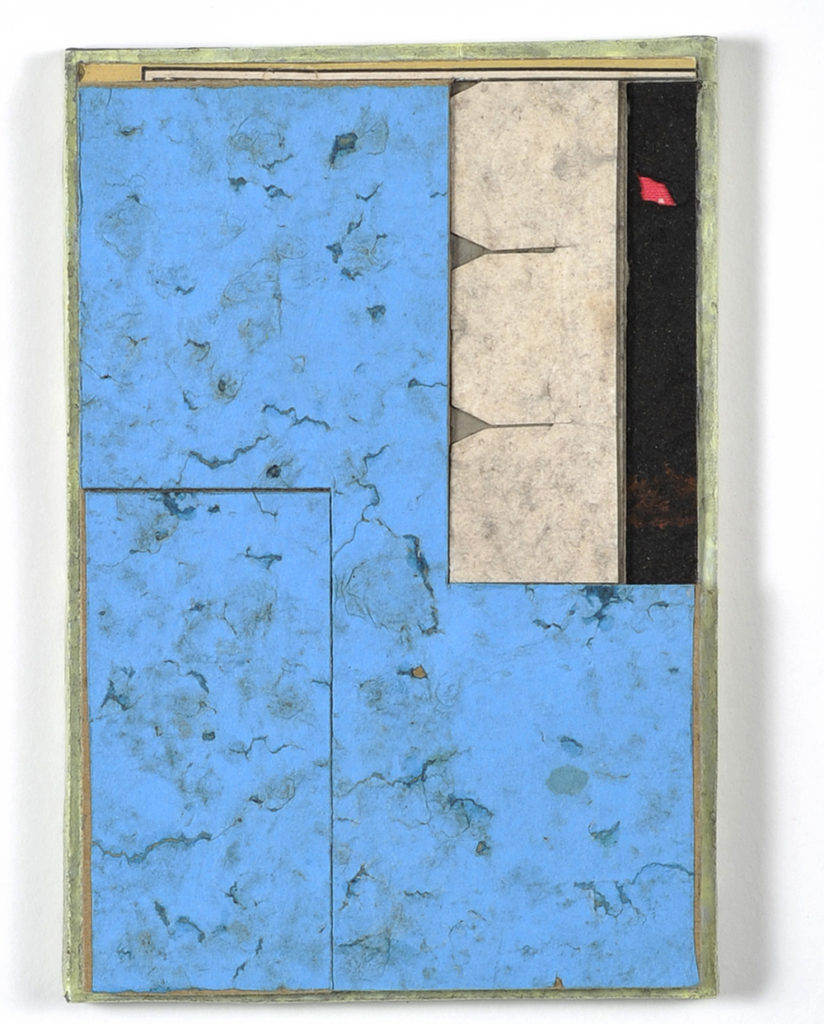
DE May, Reservoir District (224), 2001, Mixed Media. 12 x 9 inches
Each work made by D. E. May—or as his friends called him, Dan—is part of a living myth he cultivated in his artistic practice over the course of his life. This personal myth, comprised of all the million intricacies of his private existence, is firmly rooted in one place: his hometown and lifelong residence: Salem, Oregon. Dan’s was a myth constructed around the specific tenor of his relationship to that place and the momentous sensuous and emotional character—neither narrative nor history—of this illuminated rapport between dweller and dwelling.
His work can certainly not be fully understood outside of this context, but even insider information as to the particulars of this local sphere will not permit guaranteed access. More mysterious than the autobiographical sketch, the reflective memoir, or the repetitive analysis involved in self-portraiture, Dan’s works remain inscrutable psychosomatic reservoirs of experience, holding the moment of their making in a state of suspension.
His art is unknowable both despite and because of its intimacy. This riddle initially frustrated me. The tension arose not because Dan’s work is so often unpredictable, as when it evokes aspects of high-modernist abstraction via lovingly reconstituted remainders of discarded trash found in Salem’s downtown alleyways. This high-low aesthetic twist is an appealing schema in the work, but not its core. Rather, I was dissatisfied precisely because of my passion for the work and my desire for proximity to it.

DE May, Reservoir District (224), 2001, Mixed Media. 12 x 9 inches
Each work is a distinct fragment of Dan’s space, evidence of his encounter with a moment. Yet the works are not at all about the artist, they do not tally his memories or reconfigure his sensations. The artist is not present in them. Whether it was an old postcard he refitted for mailing and sent to my house, or a booklet of miniature collages he bestowed on the occasion of my wedding, these constructions always gestured toward the same thing to me when I was finally capable of sensing it: they are places.
My attempt to get to know Dan and his practice started when I was a newcomer in Oregon a decade ago. During the initial months of my debut university post, I encountered Dan’s work in reverse order. Instead of seeing finished pieces in a gallery or museum setting, poised and priced, I visited the artist’s legendary workroom in downtown Salem, a space he called the Regionaries Club. Standing in that dim undersea atmosphere, constructed entirely of gleaned refuse and industrial scraps, my art historical mind-set instantly jumped to those comparisons nearly all writers make when discussing Dan’s work: Duchamp appeared in the penchant for compulsive measurement; Kurt Schwitters’s Merzbau found a West-Coast correlate between those walls; imprint, index, and the aesthetics of the archive rallied to the tip of the tongue.
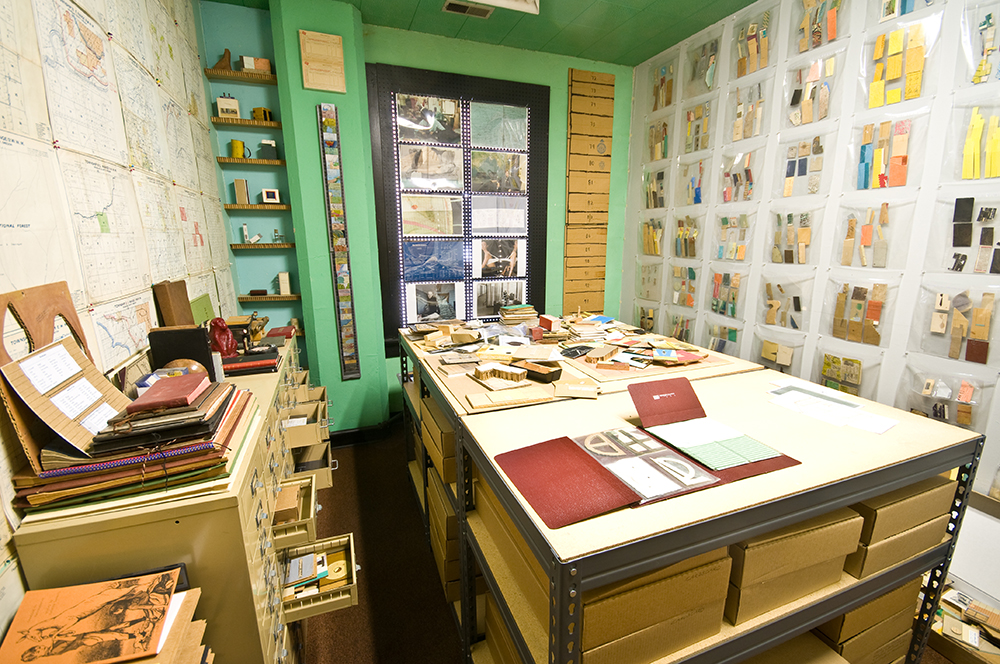
DE May studio shots.
Photo by William Bragg, 2008.
Over the years of getting to know Dan better, I realized that such comparisons are ultimately ill-fitting. Dan himself agreed with this, I think, despite his respect for avant-garde predecessors, especially Duchamp. If modernism is present in his practice, it is modernism as heavily filtered through rows of bank cubicles, janitorial closets, and small business storefronts amidst Salem’s circumscribed city center. Nor are the artist’s frequent dips into a spare type of figuration reliably art historical or even concretely referential. While Dan’s constructions tend to conjure reveries of microcosmic and macrocosmic architectures, or lost ledgers of forgotten engineers, in the end they resist metaphorical and speculative reflections.
His materials speak to local industries, even when they are repurposed shipping boxes mailed from afar, found in a back alley. Dan built his œuvre out of the most abstracted products of the Oregon logging industry, from wood pulp and chips, to glassine and embossing—so many trappings of our mail-order information society. The word manufacture, when taken in its etymological sense, manu factum (made by hand), comes to mind. Dan turned the soggy, scraped, and faded remainders of technocratic product distribution into homemade monuments. He remade the machine-made.

DE May studio shots.
Photo by William Bragg, 2008.
During my final visit to Dan’s work space—over a too generous glass of whisky, The Ipcriss File soundtrack playing on vinyl in the background—I was able to resign myself to the idea that Dan’s art was as elusively singular as the man himself. As an art historian, I had hoped to do better with the artwork at least.
The truth is that I barely got to know D. E. May, despite the fact that I think he would agree we were friends. To this day, I still struggle to be as present as possible with the work as it exists in its own space and distinct specificity. And if it seems that I mourn what I am calling the supremely intimate unknowability of his art, it may just be that my own grief over his recent loss seeps through my words.
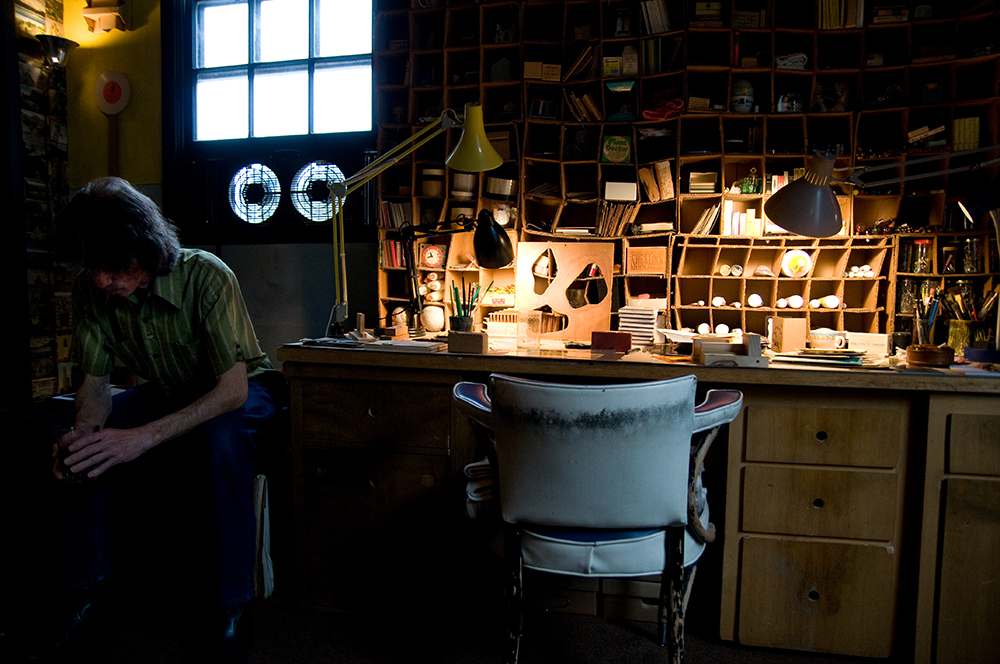
DE May studio shots.
Photo by William Bragg, 2008.
He is of course irreplaceable, but as he once stated, the work itself will last. In that case, what I mean to say is, the lesson he taught me about his work’s solidly emphatic identity is not a cause for lament. Actually, the emotional and cognitive abundance of Dan’s personal myth of “Islandsalem” somehow arrives in my awareness intact as a kind of gift, a durational paean to his existence, which in turn brightens my own. Although Dan’s work was not a homage to Salem, it is my experience of the work as generous—despite its unknowability—that allows it to morph into an homage to the artist himself.
It is natural for Dan’s many friends and admirers to continue to look for him in the corner booth of his favorite bar in Salem, and to search for his inimitable silhouette moving across the nighttime streets. His relationship to his city, however, is not reliably characterizable. Salem: where the river undertakes serpentine curves; state capitol; bureaucratic zone of hospitals, trials and incarceration; blossom-filled flood plain; venerable university town; (and in recent years, site of protest and toxic smoke). The most mundane manifestations of life in Salem composed Dan’s exquisite mythic horizon. Such a patient and diligent lifelong habitation of a place the artist called home offers an astounding example of the buoyant possibilities for being to anyone who can embrace it.
I am grateful to Dr. Sue Taylor and to Jonathan Bucci, John Olbrantz Curator of Collections and Exhibitions at the Hallie Ford Museum of Art, for their assistance with this essay.
In her wide-ranging research devoted to Modern and Contemporary Art History and visual/material culture, Abigail Susik focuses on the intersection of international surrealism with anti-authoritarian protest cultures. She is the author of Surrealist Sabotage and the War on Work (Manchester University Press, 2021) and co-editor of the volumes Surrealism and Film after 1945: Absolutely Modern Mysteries (Manchester University Press, 2021) and Radical Dreams: Surrealism, Counterculture, Resistance (Penn State University Press, 2022). Her work has been published in The New York Times, The Washington Post, and the Los Angeles Review of Books, and she has contributed many essays to publications on the history of the avant-garde, including Surrealism Beyond Borders (Metropolitan Museum of Art; Tate Modern, 2021). Susik is a founding board member of the International Study for the Society of Surrealism and co-organizer of its annual conferences. She is an Associate Professor of Art History at Willamette University.